The soaring skyscrapers and burgeoning modernity of Hong Kong are truly a wonder to behold. But like any great city, there’s more to it than meets the eye. Look past the glass and steel, and you’ll discover a treasure trove of heritage destinations that tell exciting stories of Hong Kong from a bygone era. The following places in Hong Kong demand that you see them up close, appreciate their beauty and listen closely to whispers from the past.
Also read: Explore Beautiful Hong Kong Hidden Gems in Nature (2024) – Part 1
Must-visit heritage destinations in Hong Kong
1. Sik Sik Yuen Wong Tai Sin Temple

Amidst the hustle and bustle of Kowloon sits the famous Sik Sik Yuen Wong Tai Sin Temple. This sacred worship site was built in dedication to the Taoist deity of the same name. Wong Tai Sin Temple is incredibly popular among locals and travellers alike, as a site of veneration and heritage. Brass dragon statues flank the entrance, their forepaws bright and shiny from being rubbed by visitors to the temple hoping for auspicious luck.
A set of stairs leads people from the main entrance to a wide courtyard where you’ll find the Jinhua Heritage Pai Fong. This massive ornamental gateway marks a grand passage that leads to the Main Altar of Wong Tai Sin Temple. It’s a popular spot for pictures, thanks to a variety of intricate and colourful carvings that adorn every surface, with the main motif being dragons.

The courtyard itself is filled with brass statues of the twelve animals in the Chinese Zodiac. The surrounding wall is covered in hundreds of small, hanging brass lanterns, creating a striking tapestry of red and gold against the grey stone. Beyond the statues, a set of steps leads down to a smaller area where devotees can set their joss sticks alight in special burners before bringing them to the Main Altar for prayers.

At the Main Altar (which is a sizeable courtyard in its own right), prepare to be wreathed in a heady cloud of incense smoke as throngs of eager devotees pray and place their joss sticks before various smaller altars. The inner sanctum of the temple is gated off, but you can still see the elaborate carvings, statues, and large altar within.
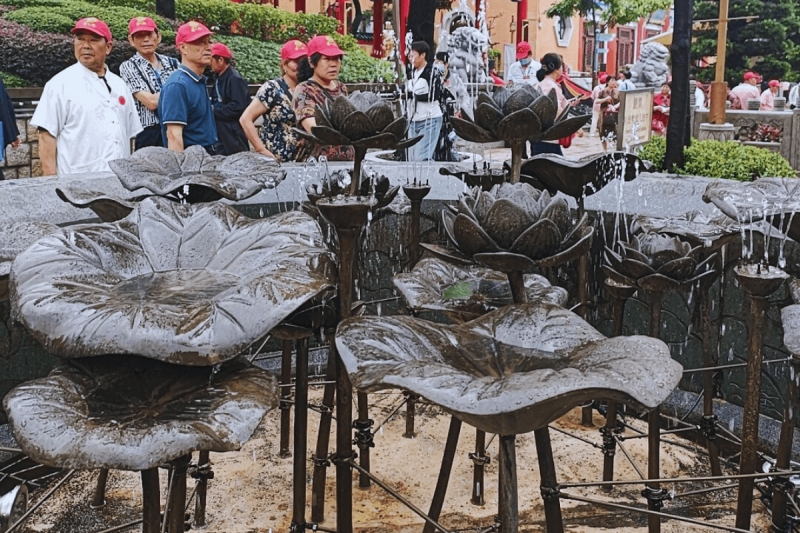
Beyond the Main Altar is a large garden area holding more landmarks of the Wong Tai Sin Temple. There’s the Yuk Yik Fountain, a stone basin in which water trickles endlessly over elaborate steel flowers, symbolising Water, one of five phases in the Chinese philosophy of Wuxing. Nearby is the Yue Heung Pavillion, which is a colourful structure that represents the Fire phase. The rest of the three phases are represented by the Fei Luen Pavillion (Metal), the Scripture Hall (Wood), and the Earth Wall, which speaks for itself.

Finally, don’t miss out on taking a picture with the Golden Wall of Wong Tai Sin Temple. This stretch of metal panels is filled with intricate carvings that make up a grand mural depicting the life of Wong Tai Sin. Wong Tai Sin Temple is easily reached by taking the MTR, where you can get off at a station bearing the same name. After that, it’s just a short walk to the entrance.
2. Ping Shan Heritage Trail

Image credit: 姒姓賢寧 | Wikimedia Commons
The Ping Shan Heritage Trail takes hikers on a route that explores the residential neighbourhoods of Hang Mei Tsuen, Hang Tau Tsuen, and Sheung Cheung Wai. The journey explores a series of incredibly well-preserved heritage buildings built by the Tang clan. The Tang settled in Hong Kong sometime in the 11th century and are officially the oldest family in Hong Kong, surviving the days of British colonial rule with their lands, properties, and legacy intact.
Among the many landmarks of the Ping Shan Heritage Trail is the Hung Shing Temple, erected in honour of Hung Shing, the God of the South Sea. The temple has stood for more than 200 years and comes alive with festive celebrations during the Hung Shing Festival on the 13th day of the Lunar month.

Image credit: Mk2010 | Wikimedia Commons
Besides that, keep an eye out for the Kun Ting Study Hall. Located in Hang Mei Tsuen, Kun Ting Study Hall was built by Tang Heung-Chen of the 22nd generation of the Tang Clan in honour of his father. The grandly decorated hall provided facilities for both ancestral worship and education.

Image credit: simplethrill | Flickr
Adjoining the Kun Ting Study Hall is another heritage building called Ching Shu Hin, a guesthouse for prominent visitors and scholars. Ching Shu Hin is a richly decorated building, in line with its role as a guesthouse, with carved panels, plaster mouldings, and patterned grilles.
3. Ex Sham Shui Po Reservoir

Image credit: 香港遺美 Hong Kong Reminiscence | Wikimedia Commons
An interesting historical tale of Kowloon’s water supply can be found at the Ex-Sham Shui Po Reservoir on Mission Hill. It was rediscovered in 2020, after being decommissioned for a few decades. The structure very much resembles an ancient Roman reservoir, with large granite pillars and red-brick arches. The Sham Shui Po Reservoir was built in 1904 to increase water supply in the early years of Hong Kong, supplying water to people in Sham Shui Po, Kowloon Tong, and Tai Hang Tung.
In recent times, it has been lovingly restored as a tourist attraction with yellow lighting that complements the graceful arches and majestic pillars. Visitors to the reservoir can explore it by booking a guided tour with the Hong Kong Water Supplies Department. The number of guided tours each month is limited, so make sure to book yours in advance if you’d like to visit!
4. The Blue House

Image credit: 方畢可 | Wikimedia Commons
Located in Wan Chai, The Blue House earned its moniker from the beautiful and eye-catching shade of blue taken on during a renovation project in the 1990s. A typical Lingnan-style structure built in 1922, it has wide balconies and was once home to kung fu studios, Chinese schools, and even a free clinic.
Until today, there are still residents living there, including a few businesses. The Blue House is one of many similar colourful buildings in the area, including the Yellow House and Orange House. To learn more about these heritage buildings, you can visit the House of Stories, which is a free gallery that’s brimming with antiques, artifacts, and multimedia exhibitions.
5. Man Mo Temple
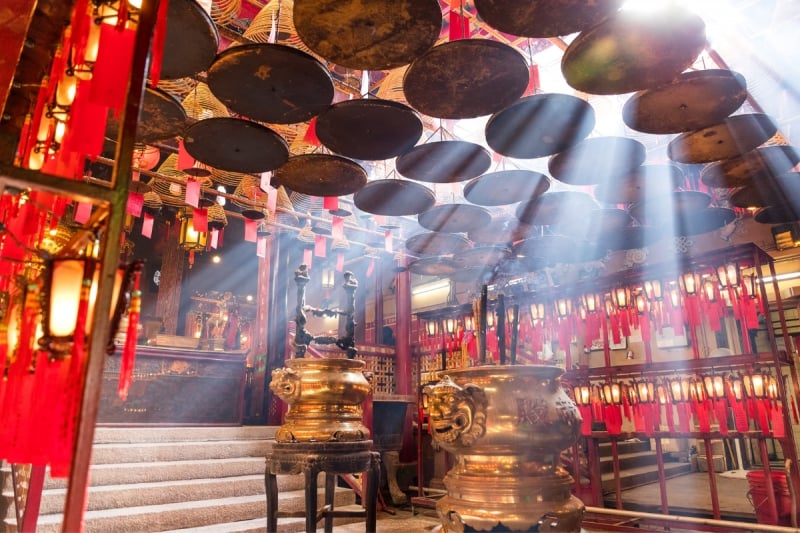
Image credit: Leung Cho Pan via Canva Pro
Built between 1847 and 1862, Man Mo Temple is a beautiful tribute to the Civil God (Man) and the Martial God (Mo). It is the largest Man Mo Temple in Hong Kong and is famous for its giant hanging incense coils. The temple compound is exquisitely decorated with granite carvings, ceramic figurines, wood carvings, and murals that are terrific examples of traditional Chinese vernacular architecture. The temple is mostly visited by locals seeking help or blessings from the Civil God for students in their families.
Also read: Explore Beautiful Hong Kong Hidden Gems in Nature (2024) – Part 2
6. Sam Tung Uk Village

Image credit: Chong Fat | Wikimedia Commons
Much like the historical buildings of Ping Shan Heritage Trail, Sam Tung Uk Village is a living monument to Hong Kong’s heritage. Built by the Chan clan in 1786, the village contains several houses and the Chan Family Ancestral Hall, which is the main draw of the attraction.

Image credit: Wpcpey | Wikimedia Commons
The entire place was restored in 1987 and reopened to the public as the Sam Tung Uk Museum. Visiting the village provides insight into how rural life in Hong Kong flourished before urbanisation began. Points of interest in the village include the master bedroom of Sam Tung Uk, featuring an elaborately carved wooden bedframe and the lanterns meant for newborn sons hanging in the ancestral hall.
7. Victoria Peak & the Peak Tram

Image credit: @ceceliachang
Often called Hong Kong’s most spectacular destination, Victoria Peak and its accompanying Peak Tram are steeped in history. It first opened in 1888 for use by the British governor and residents of the Peak. Today, it continues to be of service daily as one of the oldest functioning railways in the world. The archaic design of the tram adds a feeling of charming nostalgia to the ten-minute climb to Victoria Peak, offering beautiful views of the lush green hill and the city surrounding it. The skyscrapers of Hong Kong seem to glide past at gravity-defining angles as the tram makes its ascent to the Peak, 1,300 feet above sea level.
Here’s a hidden tip! Travellers that are feeling a little more adventurous can also hike up the Pok Fu Lam Reservoir to reach The Peak instead of taking the tram.
At the Peak, visitors can enjoy more scenic city views at Sky Terrace 428 atop the Peak Tower. Besides that, they can also visit Madame Tussauds Hong Kong to peep at the lifelike recreations of celebrities worldwide.
8. Aberdeen Fishing Village
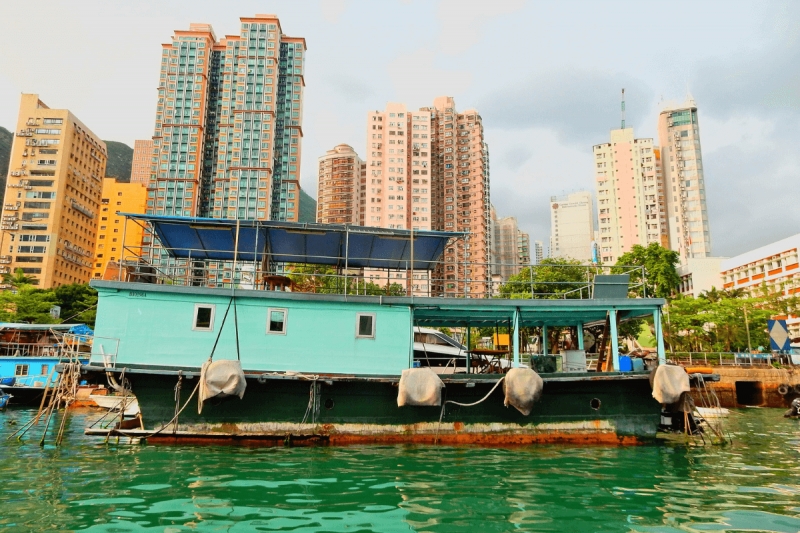
Image credit: Andrew Milligan | Wikimedia Commons
At first glance, the quaint and peaceful Aberdeen Fishing Village seems worlds apart from the glitz and glamour of urban Hong Kong. In reality, Aberdeen is easily accessible via the MTR South Island Line, with visitors disembarking at Lei Tung Station. Prepare to be greeted by the sight of rows and rows of old-fashioned junks and sampans. A few houseboats also remain scattered about, where fishermen still live with their families.
Aberdeen Fishing Village is a great place to catch sunset views by the waterfront and get your hands on some of the freshest seafood in Hong Kong. The Aberdeen Wholesale Fish Market, built in 1950, is the largest wholesale fish market in Hong Kong and supplies roughly 70% of Hong Kong’s live seafood. A fishermen’s canteen in the market serves up fresh catch from 4 AM onwards, daily.
One of the best ways to see Aberdeen Fishing Village is with a sampan ride across the harbour. Don’t worry about finding one. The local Tanka women who run the sampans constantly approach visitors and offer rides, with a general asking price of HKD 80 (which can be negotiated down to HKD 50, if you know your stuff).
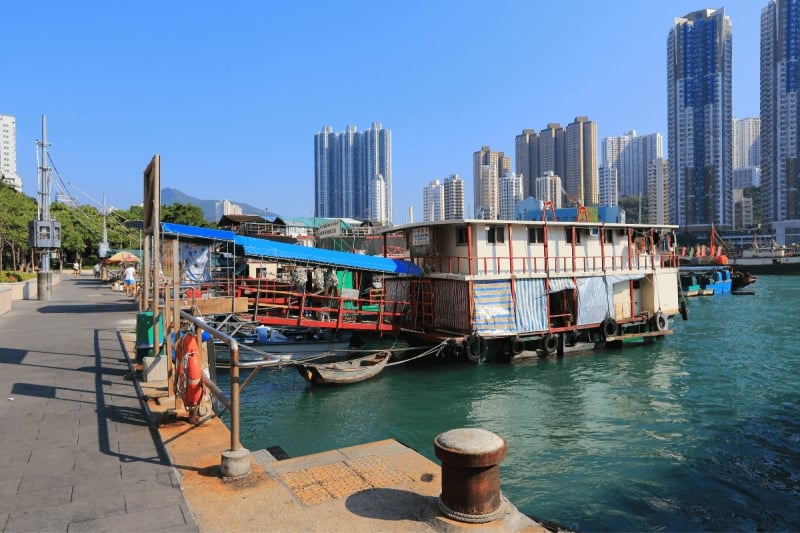
Image credit: seaonweb via Canva Pro
Besides that, you can also walk along Aberdeen Promenade and discover the Dried Seafood Stalls and Seafood Market. Fun fact; Aberdeen Harbour is the destination where the British first set foot upon arriving in Hong Kong because it was the centre of the incense trade. It’s how the name ‘Hong Kong’ was born, as it translates to mean ‘Fragrant Harbour’.
9. The Fringe Club
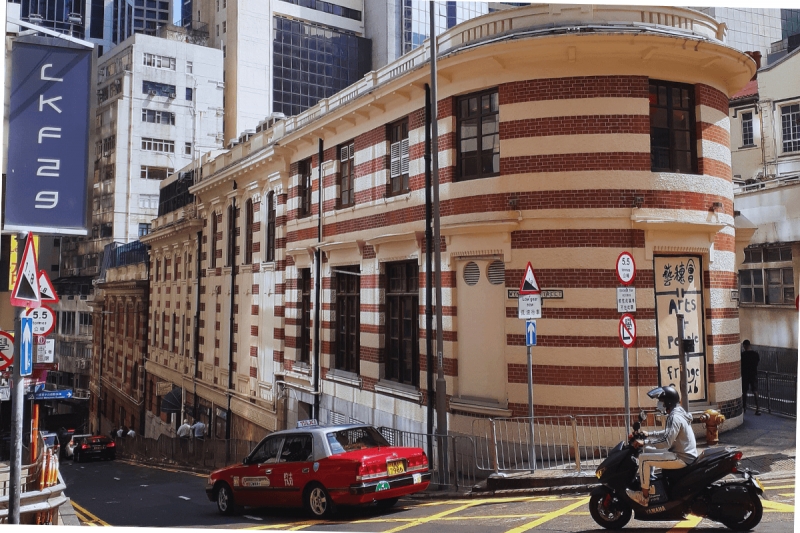
Image credit: Naus Kami Shea Man | Wikimedia Commons
The Fringe Club is a contemporary space for visual art exhibitions and theatrical productions. It sits within a historic building that originally housed Hong Kong’s Old Dairy Farm Depot. The Fringe Club shares this space with the Foreign Correspondent’s Club, which has been a huge supporter of the local art scene in Hong Kong since 1984. From musical performances and dramas to poetry reading and art shows, it’s one of the best places to indulge yourself in Hong Kong’s art scene.
10. Western Market

Image credit: WiNG | Wikimedia Commons
Sitting in a gorgeous Edwardian-style building, Western Market is a shopping complex featuring shops that sell arts and crafts, and fabric merchants who originally plied their trade in the old alleys of Central. The structure itself was completed in 1906 and features a beautiful red brick exterior with a granite arch over the main entrance and eye-catching ‘bandaged’ brickwork. It’s the oldest surviving market building in Hong Kong and is also home to various cafes, restaurants, and curio shops.
Also read: An Urban Explorer’s Guide to The Best Places to Shop And Play in Hong Kong
The grand tapestry of Hong Kong’s past co-exists with its modern-day self in complete harmony. Weathered harbours and old temples stand shoulder-to-shoulder with skyscrapers, boutiques, and so much more. There are plenty of interesting and exciting stories that await travellers who set foot on the islands. All you need to do is pack your bags, fly down, and start exploring!
Brought to you by the Hong Kong Tourism Board.




